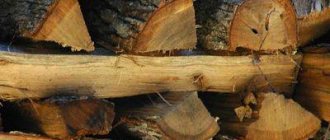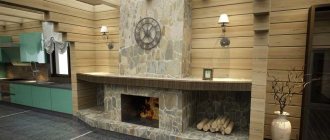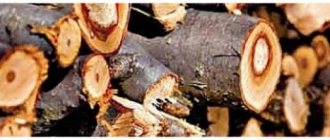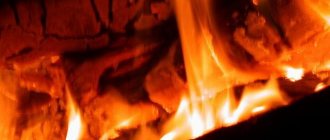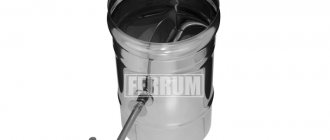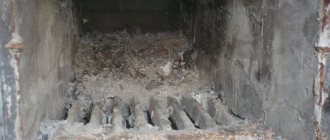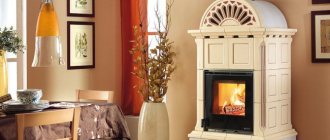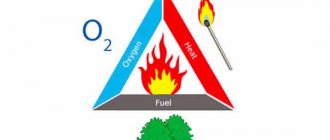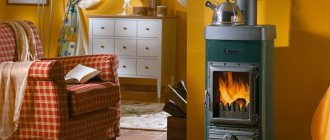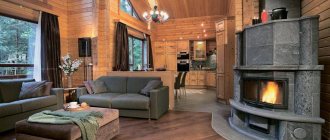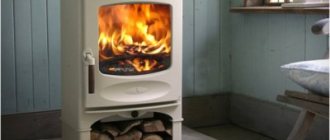Basic principles
When you have already decided what is better to light the fireplace, you need to remember several important points.
It is not advisable to use wet firewood for the fireplace. They will flare up poorly. Moreover, often after using raw firewood, condensation accumulates on the inner surface of the chimney, impairing the performance of the entire structure. The best firewood for kindling is one with a moisture level of no more than 20%.
In order for a freshly cut tree to reach this state it is necessary:
Store it in closed areas with good ventilation for two years or subject it to forced drying in specialized conditions.
What should the logs themselves be like? They shouldn't be too thin. The best option is chopped firewood, the diameter of which varies from 6 to 8 centimeters. Wood intended for burning should be stored outdoors under a canopy. This storage method guarantees the required level of humidity.
Firewood under the canopy
An important point is that the logs should not be too dry. If the firewood is dry, then there is a high probability of getting a “jumping” fire instead of even burning.
Important - you should not light the fireplace with a variety of chemical-based compositions
Preparation
Before dealing with fire, you should prepare the fireplace for use. Even if you heat it daily, still do not neglect this step for your safety.
- It all starts with a chimney inspection. The accumulation of soot on its walls can lead to uncontrolled combustion, that is, to a fire. Soot contains flammable resins and a substance called creosote. They need to be disposed of in a timely manner.
- While the fireplace insert is not filled with wood, you should check the draft. This is easy to do if you set fire to a piece of old newspaper. If there is draft, the fire flame will clearly deviate towards the chimney.
Each owner independently determines what to light the fireplace with, but there are a number of tips that you need to heed. Each of us has wondered why dry wood burns better. Damp firewood contains moisture between the fibers. It is necessary to transfer the amount of heat for a long time so that it completely evaporates, and only then the firewood will ignite.
Dry firewood, ready to use
Therefore, if you have a wood-burning fireplace, you should use only dry logs, preferably hardwood. Of course, you can melt it with wet wood, but it will require a lot of effort from you. A freshly felled tree is suitable for firewood after a year of proper drying, so owners of wood-burning fireplaces have pre-prepared supplies in woodpiles.
There are also certain requirements for the external parameters of firewood. Their length should not exceed 40 cm and be about ¾ of the width of the firebox. As for specific breeds, preference should be given to those that provide more heat. Examples include beech, yew, oak, and birch. It is not recommended to use coniferous trees, as the resin they contain will produce a lot of soot and smoke.
Do not allow wood to burn too high
There are three wood burning modes: low, high and optimal.
When the mode is reduced, the firewood does not burn completely and produces a lot of soot. If it is higher, you waste firewood: part of the heat flies away through the chimney, since the heat exchanger and the room do not have time to remove it completely. This occurs in two cases: you use too much wood or supply too much air. It is necessary to reduce the volume of the bookmark or draft.
The best option is when the wood burns in the optimal mode: not weakly and not strongly. The easiest way to determine the combustion mode is to use a combustion indicator, which shows the current mode in real time. If the temperature of the flue gases is more than 320 degrees, then the firewood burns at high speed.
The combustion indicator determines the flue gas temperature and combustion mode in real time
Coniferous firewood - pine, spruce, larch
Coniferous wood contains a large amount of resin, which promotes rapid and intense combustion with a large release of smoke and soot. Regular use of pine firewood contributes to the formation of thick layers of soot on the walls of the chimney.
Coniferous firewood logs
That is why coniferous wood is practically not in demand for heating houses; it is used to kindle stoves in bathhouses. The melted hearth of pine needles fills the steam room with a classic spruce aroma, which calms the nerves and has a beneficial effect on the respiratory system. The forest pine aroma appears thanks to the essential oils present in the pine needles. When burned, spruce and pine firewood produces a characteristic crackling noise that many people enjoy.
Note that burning coniferous wood is difficult to extinguish, and the embers flying out of it make this wood the most fire hazardous. Therefore, it is best to heat a closed stove or fireplace with pine or spruce firewood.
After analyzing all existing types of wood, you can easily find the best firewood for heating stoves in your home and bathhouse. Use different tree species, find the optimal solution for a specific situation. Enjoy the pleasant aroma, warmth and comfort that burning wood firewood gives you.
Coniferous firewood is valued for its unique resinous aroma
Spruce firewood is not as hot as pine firewood - keep this in mind when preparing. Larch firewood is used quite rarely - this type of wood is not that common in our country. But if you come across such logs, remember: when burned, they form a lot of carbon monoxide, so in no case rush to close the damper and take care of good ventilation. By the way, soot and soot from resinous pine firewood will settle on the walls of the stove and chimney no less than from birch firewood.
Fireplace operation: ignition and selection of firewood
If you are still dreaming of your first fireplace or have already bought one but have not yet lit it, you may think that kindling is a difficult task. In fact, this task is quite simple - for those who know the main rules of ignition and have become skilled at it.
To ensure that your fireplace gives you pleasure from the first time, choose the right firewood and kindling material. Use dry wood to fuel the fireplace to help maintain an even and calm fire. The best wood is hardwood: maple, oak and others. Firewood made from aspen or alder is useful for cleaning soot from the chimney.
Coniferous wood is not suitable for use in fireplaces, as during combustion a large amount of creosote is released, which settles on the walls of the chimney.
When choosing firewood, pay close attention to its quality, especially its dryness! Wet wood pollutes the chimney and exhibits poor heat transfer, so the wood must be sufficiently dried. The humidity level is ideally no more than 20%, so firewood is dried for more than one season.
Do not heat the fireplace with chipboard, fiberboard or furniture: they contain chemicals that, when burned, release carcinogens.
Never use flammable combustible substances for kindling! They are harmful to health, a fire hazard and have a bad effect on the longevity of the firebox. Take only paper and firewood.
An excellent natural kindling is dry birch bark.
Having a strong enough draft is half the success in lighting a fireplace. The pipe should be free, and the air in it should move from the house to the street, and not vice versa. To ensure that the chimney is functioning properly, it is checked and cleaned twice a year. And before each kindling of the stove, the presence of draft is checked using paper.
If the flame from a piece of newspaper set on fire in the firebox deviates towards the pipe, the draft is correct. If not, check to see if the stove damper is closed. In cold and damp weather, draft may be hampered by a column of “heavy” air inside the chimney. To drive it away, try burning old newspaper directly under the pipe.
A persistent lack of draft indicates foreign bodies in the chimney cavity, including blockage by accumulated soot. In such cases, the chimney must be cleaned immediately. If the urge comes, it’s time to carry the wood!
There are two main methods of kindling - from below and from above. In Russia, kindling from below is popular because of its simplicity and speed. However, kindling from above is not that much more difficult, and the combustion is slow and even. The heat doesn't go down the drain. Top kindling is actively used in Europe, and it came to us from there.
Before adding firewood, do not try to sweep away all the ash from the hearth. A small layer is a catalyst for combustion, protection against overheating of the firebox. Ashes are removed from the hearth firebox only when there is too much of it. If you have a fireplace with a grate, then keep the grate clean for better air access and proper draft.
When kindling from below, place small splinters or branches at the bottom, followed by medium logs, and a few really large logs at the very top.
When kindling from above, the base of the wood pyramid is made up of heavy firewood, and small ones are placed on top of them. Do not try to pack the firebox tightly with wood. Leave room for air!
A small life hack: it’s easier to light a fireplace if you put a sheet of crumpled paper on the grate and some wood chips or shavings on top. This way the air gets to the fire much better. The door must be kept open.
Carbon monoxide is so dangerous that before starting the fire, you need to check again whether everything is in order with the draft. Just like the first time, we set fire to another splinter or piece of birch bark. If the flame stretches towards the chimney, it means you can set fire to the wood!
Roll dry paper or birch bark into a tube and bring it to small branches. Make sure they light up. Watch how the fire gradually spreads to large logs. Close the firebox door or fireplace shield only after the flame is well lit. Then, by adjusting the air supply, the required operating mode of the firebox is set.
The main laying of firewood is done when the shavings and chips burn down to coals. But remember: the amount of firewood in the firebox should not exceed 2/3 of the volume of the combustion chamber. This is a mandatory standard that prevents the fireplace from overheating in extreme modes.
Therefore, new firewood is added gradually to maintain a stable flame. In this case, the door is kept slightly open for 3-4 seconds in order to prevent smoke when adding firewood, and only then is it opened completely.
For the fireplace fireplace, choose dry wood to help maintain an even and calm fire.
To create intense combustion, it is recommended to add a lot of small firewood, and to create a calm and uniform combustion, use large logs. If you want to make the flame big and spectacular, add roots or tree stumps. And juniper, cherry and apple will help you get a pleasant smell.
For an inexperienced person, the firewood may not light up the first time. Everything is fine! Try again. Any new skill requires repetition to take hold. After a few kindlings, using the fireplace will become easy and pleasant for you. And the main advice: when operating the firebox, always remember fire safety precautions!
Choosing firewood for the fireplace
Many people wonder what type of wood is best for burning a fireplace. Preference should be given to hardwood, which should be dry. If you heat a fireplace with wood with a high moisture content, the amount of ash and smoke will increase, and condensation will appear. Dry firewood is easy to distinguish: it is mostly dark in color, has cracks at the ends, and produces a clear sound when burning. The moisture content of recently felled trees exceeds 50%. Wood can dry completely in about a year.
This is what dry firewood usually looks like
You can store timber both indoors and outdoors. The classic storage option is a woodpile. It is recommended to stack firewood in each next row perpendicular to the previous row. Logs can also be placed in a room where a fireplace is installed. To do this, a special niche (firewood box) is made in it, into which the raw materials for kindling the device are placed. In this case, the firewood is usually located under the firebox. It is necessary to carefully isolate the place of their storage. If you are not sure of proper compliance with fire safety regulations, firewood should be placed away from the fire.
It is best to store firewood in split form. Their optimal thickness should be 6-10 cm, and their length should be 3/4 of the width of the firebox. The average length of firewood, as a rule, is 30-40 cm. Hardwood, which burns quite slowly, has the greatest heat transfer. These include:
- birch;
- beech;
- pear;
- oak;
- yew;
- ash.
Wood of medium hardness gives off less heat:
- cherry;
- elm;
- cedar;
- fir.
Soft coniferous wood produces a relatively small amount of heat, but after combustion it leaves a lot of soot that settles on the internal walls of the fireplace. These include:
- spruce;
- pine.
Such wood can be split without much difficulty. If you burn with pine wood, you need to remember that a large number of sparks are likely to appear. They can damage the floor covering and cause a fire. At the same time, many users do not think much about whether it is convenient to light a fireplace with such logs, since they like the pleasant aroma of burning pine wood.
We use pine wood as a firebox
Birch, beech, or maybe ash?
- Birch burns easily, even if it is not completely dry. Gives a good even flame and has very little resin. It has an average calorific value. You can order chopped birch firewood with delivery by calling 8 (965) 433-29-99.
- Beech burns calmly and for a long time. It has a high calorific value, so it produces a lot of heat.
- Oak burns slowly and for a very long time. Contains tannins with a pleasant bitter odor, which are released during the combustion process. Suitable for smoking dishes. It has a high calorific value and produces a lot of heat.
- Fruit trees - they burn slowly, with an even flame. They release a pleasant aroma. Apple, pear and cherry wood is used for smoking various dishes.
- Hornbeam - its wood is considered the best for heating (highest calorific value). Burns very slowly. Doesn't create a lush flame, but gives a lot of heat.
- Ash - although it burns for a long time and produces a lot of heat, it is rarely used as a fuel material. It cuts and pricks poorly, so it is difficult to prepare.
- Alder - does not burn well unless you dry it well enough. Its wood is considered one of the best for smoking. Adds flavor to dishes and improves their color.
- Poplar - has a very low calorific value and produces little heat. When wet, it does not burn at all; when dried, it burns very quickly, so it is suitable for fires.
Why does wood need to be cut?
In the forest, immediately after felling, the wood has up to 50-70% moisture. Much depends on the type of plant and the time of year (trees have reduced sap flow in winter). Such wood has a low calorific value - it burns poorly, produces little heat, and the gases released have a high content of water vapor, which easily settles on the walls and in the chimney pipes, which shortens their service life.
There is also more heat loss, because in order to be able to burn wet wood, you need to increase air draft. Therefore, before use, firewood must be properly chopped and also dried. They need two or three months to dry completely, depending on the wood chosen. It is best to buy and harvest wood in late spring or early summer, then it is cheaper and has time to dry well by the beginning of the heating season.
Beech firewood
The purchased wood is cut and chopped, then stored under a shed, while you can buy yourself firewood for two or even three years in advance, since it becomes more expensive every year, however, if you have a room in which you can store it.
During this time, its humidity drops to 15-20%. The calorific value of such firewood is about 4 kW * h/kg, while wood with a moisture content of 50-60% is only about 2 kW * h/kg. Prepared firewood should not lie directly on the ground so as not to draw moisture from it. It is better to lay them on joists or gratings. This will ensure their isolation from the ground and good air circulation. Damp wood should not be stored in unventilated areas because it will dry out slowly.
Everything is already clear with the choice of wood and its preparation. In the next video, an expert explains how to properly light a fireplace, enjoy watching.
What kind of firewood should I choose for the fireplace?
And a few more simple rules
To achieve even and long burning, it is recommended to follow a number of simple rules:
- It is better to use logs of approximately the same size;
- the main combustion should be supported by sufficiently thick firewood, and thin branches and brushwood are suitable only for preliminary kindling;
- the bark from the logs must first be removed - this way you will significantly minimize the amount of soot formed during the combustion process.
It is also important to properly place firewood in the firebox. It is strictly not recommended to stuff it full of logs - it is better to fill it loosely by about 1/3 of the volume. This way you will provide sufficient draft for the fuel to burn efficiently, but you won’t have to frequently add a new portion of firewood - it will be enough to add 2-3 logs to the firebox from time to time. The damper must be open.
Available options
In specialized stores you can find artificial firewood made from a variety of materials. Most often, plastic, ceramics, and stone are used to produce such decorative accessories. For connoisseurs of natural things, ordinary logs treated with special compounds are offered.
Natural firewood. Natural firewood is actively used to decorate fireplaces and the space next to them. They look very authentic; the subconscious mind does not reject the visual picture. In addition, the trend of environmental friendliness has been in fashion for a long time and is unlikely to be replaced by any other direction in the near future. Firewood can be chopped into small dies, you can use small logs or whole logs.
Decorating the fireplace and the entire interior with natural wood
When lighting an eco-fireplace, natural wood is, of course, removed from it, since the system runs on a completely different fuel. However, if you have a false fireplace, you may not need to get logs; the main thing is to be vigilant and take fire safety measures when installing candles.
To decorate fireplaces in your home using natural wood, you can use various types of wood. For example, for an interior in light colors, birch firewood is perfect, while for a modern, bright and unusual interior, aspen, known for its unusual wood color, would be appropriate.
Ceramic firewood. For modern bio-fireplaces, imitation firewood made from fire-resistant materials is actively used. This dummy wood for the fireplace is loaded directly into the firebox, because it is practically not afraid of the corrupting influence of fire.
Ceramic fireplace accessories
The best option for many modern systems is the use of ceramic objects. Ceramics is a very malleable material, so analogues of firewood are created with details worked out to the smallest detail, which makes them very similar to the original. Currently, ceramics are used to create:
- imitation of whole logs, chocks;
- a replica of wood burnt in a fire;
- decorative coals;
- imitation of twigs, sticks, cones.
If you look at such objects from a certain distance, you may not notice the catch, so well made is the copy. Using artificial coals for the fireplace, firewood, twigs and cones is not only good from a decorative point of view, but also from a practical point of view, since the ceramics will not catch fire, smoke or spark.
The service life of ceramic objects is very long, but still regular firing of ceramics with real fire will not pass without a trace. Most often, not the highest quality products quickly deteriorate, but good ones last for several years. The market for decorative firewood is quite large, so it contains both high-quality and low-quality options. Normal quality costs some money, and this is something to keep in mind when purchasing.
Stone options. In addition to imitation firewood, modern eco-friendly fireplaces are often decorated with decorative stones and pebbles. The stones are placed directly into the firebox. They can use regular fireplaces, or their substitutes, again made from ceramics. Most often, decoration with stones is used for fireplaces running on biofuel. Real fire passing through stones looks very impressive in such systems. At the same time, the fire itself and the decorative materials do not emit anything into the atmosphere of the room, which means that a chimney is not needed for such a device.
Modern tabletop fireplace with stones
Buying and storing firewood: what to pay attention to
Whatever type of firewood you choose, when purchasing, make sure that the raw materials are dry. Humidity reduces thermal conductivity, because When water evaporates, it takes some of the energy with it.
When ordering firewood, also keep the following recommendations in mind.
- Find out (if possible) exactly where the trees were cut down. The location of the felling is important because... wood is sensitive to the environment. It is not recommended to buy logs from swampy areas, as well as from burnt forests.
- Find out what form the firewood will be delivered in. If you are offered a car of firewood in bulk (the logs are simply piled up and not neatly stacked in the back), then after stacking their volume will decrease by about 25-30%. (1 cubic meter of stacked firewood is approximately equal to 0.7 cubic meters of piled firewood).
- Ask when the firewood was collected. The humidity of freshly cut trees exceeds 50%, i.e. more than half the weight is water. Wet firewood produces less energy than dry firewood, and also has a worse ignition and smoke stronger. On average, heating a house requires 3 times less dry wood than wet wood. It is better to buy firewood from last year.
- Specify the size of the logs. The standard length is 30-35 cm, thickness after chopping is about 12 cm. These dimensions are optimal for most ovens. However, if the firebox is short, then in this case the maximum allowable length is about 25 cm. For saunas and barbecue, you need not too thick logs so that they burn and form coals faster. Conversely, thicker logs (15-20 cm) are better suited for stoves and fireplaces, because they smolder more slowly and emit heat for a long time.
The conditions for storing firewood are of no small importance. Raw materials for kindling should be stored so that they are well ventilated, do not rot or accumulate moisture
Traditionally, firewood is stored in specially designated areas under a canopy.
In this material, we paid close attention to the choice of firewood for heating. If you are interested in what kind of firewood will produce the most delicious shish kebab or the most aromatic smoked fish, read our article
Choosing firewood for grilling and smoking The taste and aroma of grilled meat directly depend on what kind of wood you choose.
What kind of firewood do you usually choose? Do you prepare different breeds for saunas, barbecues and home heating? Or do you prefer a universal kindling material?
Which ones are best for the oven?
Any wood can be used as fuel. The main thing is that they exist. Each region has its own preferences, depending on what trees grow in the area. Many people believe that birch or alder are the best. The choice is yours.
To the bathhouse
The choice of logs for heating a sauna depends on the design of the stove. Many people prefer:
- Alder. They produce a persistent heat and burn almost smokelessly. There is a popular belief about their healing power;
- Birch. Burns evenly, the heat is strong;
- Willows. The heat transfer is low, you will need a lot of them, but the spirit in the bathhouse will be especially light.
It is not recommended to use oak ones - they take a long time to burn out, the heat is intense, and they emit a large amount of carbon monoxide. Periodically, aspen is used to clean the chimney. If the furnace firebox is remote, the main selection criterion is heat transfer.
For home heating
Hardwood firewood has the best qualities and is used more often. Birch, oak, linden - any, depending on their availability and needs. The main thing is to be dry. In fireplaces it is better to use those types that smoke less and do not “shoot”.
For garage
For heating a garage, there are no special requirements for the quality of firewood. When choosing, you need to focus on the parameters of the stove.
How to store firewood
The traditional way to store logs and chopped firewood is in a woodpile next to the wall of the house or under a canopy. Fuel is stored in large quantities, sufficient for heating for the entire cold season, and sometimes for two to three years (depending on consumption and the size of the woodpile). This option is good for a private cottage where people live permanently and there is no risk of firewood being stolen. In other cases, it is worth building a closed woodshed. More storage options:
- stand - a structure placed next to the fireplace, in which a volume of firewood is placed for several hours or weeks (the dimensions depend on the time);
- basket - placed on the floor or rack in close proximity to the stove, allows you to both store firewood and transfer it from the woodshed to the house;
- a bag is another option for carrying and temporarily storing fuel near the fireplace.
Inventories are created as follows. The raw wood, after sawing and splitting, is laid in rows in a woodpile. They are kept in this form for 3–4 months, depending on the time of preparation of firewood, so that they reach a humidity of 20% or less. They can only be kept outdoors in relatively dry climates. If the region is characterized by rainy weather, it is recommended to immediately hide the fuel under the roof. Otherwise, it will begin to rot, and an unpleasant odor will appear when burning. In addition, rotten wood produces less heat, more smoke and ash. If you follow the rules, firewood can be stored for many years without compromising its heat capacity.
Using wood as fuel
Nothing beats a real wood fire. The characteristic crackling sound and live flame are only possible if real logs are used.
There are several nuances on how to properly heat a fireplace with wood:
- It is necessary to follow the rules for storing firewood. You can heat the room only with dry wood, which contains as little moisture as possible. Firewood from freshly cut trees is not suitable. You need to use logs that have been drying for at least a year. Such firewood is easy to distinguish - it has a darker shade compared to other wood, and there are several cracks on its surface. The combustion process of dry wood is characterized by a clearly visible crackling sound.
- You need to choose logs of the same size. The thickness of the tree should be no more than 6-10 cm, otherwise the log will not burn well. The length should be ¾ of the combustion hole.
- To fire the fireplace, a horizontal method of laying firewood is used. The logs are placed in the combustion hole next to each other with a gap of 1 cm. The height of the stack should not exceed 30 cm.
Another important criterion for how to light a stove is the choice of wood species for lighting the fireplace.
What wood is suitable for fireplace inserts?
How warm the room will be after lighting the fireplace, how much soot and smoke there will be - all this depends on the type of wood for kindling. You need to know exactly what kind of wood is best to burn the fireplace with. The following types of wood are used for kindling:
- Hardwood. These include birch, hawthorn, pear and apple. It is a malleable wood that burns easily. During the combustion process, a minimal amount of tar and soot is released.
- Hard rocks. For long burning, it is better to choose oak, yew and beech logs. This type of firewood is difficult to split and takes quite a long time to light. But logs will burn much longer than other types of wood.
- Softwood. Elm, cherry, cedar and fir produce much less heat than other types of wood. In addition, the logs smoke heavily and a large amount of soot and ash is formed. You should refrain from choosing such logs if the fireplace chimney has a rectangular shape and a small hole. If the air duct draft is weak, smoke can fill the room.
- Coniferous species. To create a pleasant aroma in the room, pine and spruce logs are used. Coniferous trees burn quickly, but the flame is uneven and many sparks are produced. A large amount of smoke and soot is also released. Due to the high resin content in coniferous trees, embers may fall out of the fireplace, which is quite unsafe.
- Cleaning rocks. These include alder and aspen. Wood does not emit smoke during combustion. Using alder and aspen firewood not only does not emit soot, but also cleanses the chimney of soot. It is advisable to heat the fireplace during frequent use with cleaning logs at least once every two weeks.
- Fragrant branches. You can add fragrant tree branches to the fireplace flame, which will fill the room with a pleasant smell. You can use branches of fruit trees. Adding juniper branches to the fire will bring a healing and relaxing effect.
Whatever type of wood is used to fire the fireplace, you should choose only dry wood. If tree branches and logs contain a lot of moisture, the fireplace will become covered with soot and soot, which can weaken the draft in the chimney.
WHAT IS THE BEST FIREWOOD FOR A CAST IRON STOVE? WHAT TO BURN THE FIREPLACE?
A fireplace or stove is not only a beautiful decorative element, widely used in modern interiors, but, above all, a reliable source of heat generated when wood is burned. The choice of fuel for heating a fireplace or wood stove affects not only the efficiency of the heating device, but also its appearance, service life and heat output. Therefore, the issue of choosing fuel for a stove or fireplace should be approached responsibly. We will try to tell you in detail what types of fuel can be used to heat a stove or fireplace, and what it is better not to use.
WHAT CAN YOU LIGHT A FIREPLACE, STOVE?
Of course, a real classic fireplace is not associated with anything other than firewood. But, modern living conditions make their own adjustments, and in addition to the aesthetic beauty of a living flame, the consumer also demands that when fuel burns, the maximum amount of heat is released, and the period of operation of the stove from one stack of firewood is as long as possible. All this has led to the fact that for fireplaces and long-burning stoves, manufacturers began to produce long-burning firewood - compressed fuel, similar in structure to pellets, but having larger dimensions. This raises the question: “Is it possible to heat a wood-burning stove with briquettes?” Pressed logs, Euro-firewood, briquettes - all this is the name of one type of fuel, made from crushed wood of different species, coal, peat and characterized by good heat transfer and a long burning life. However, heating a stove or fireplace with European wood has several features. Let's look at them in more detail: wood briquettes flare up well and maintain stable combustion for 8 hours when the fireplace is fully lit. Peat briquettes will need to be lit in batches, first you need to light a small amount of wood to give the pressed logs a good fire, and then add a new batch of briquettes. The burning time of European peat firewood reaches 6 hours. When burning any kind of briquettes, be it fuel briquettes or wood briquettes, the heat released is almost 30-50% more than when burning conventional firewood, while the burning time of eurowood is almost twice as long. How is such a long burning time achieved? When comparing briquettes for combustion and firewood, you need to understand the principle of the process of producing compressed fuel. During processing, moisture is completely removed from the crushed raw materials (specific humidity does not exceed 11%). Then, small particles are pressed so that there are no voids left between them, which ensures a high density of briquettes and guarantees uniform combustion without sparks, with minimal smoke emission, which is important for open fireplaces. During the production process, resinous inclusions are also removed, therefore, fireplaces and fireplaces can be heated with briquettes even from coniferous wood. However, it is worth considering that the heat transfer of compressed fuel made from coniferous wood is less than that of analogues made from hard wood. However, when choosing what to heat the fireplace with, real wood or briquettes, keep in mind that the characteristic smell of burning wood and the soothing crackling sound is only possible when burning chopped wood.
WHAT FIREWOOD SHOULD BE USED FOR A FIREPLACE?
The best firewood, which has high efficiency and the greatest heat capacity, is prepared from hardwood. Beech and oak are optimally suited for fireplace or stove inserts; acacia, aspen or any fruit tree can be used. Beech and oak are rightfully considered “elite firewood”. These rocks burn evenly and brightly, pleasing to the eye. During combustion, a pleasant and even crackle is observed. Beech firewood, in terms of its heat output, has practically no equal. Oak firewood also has similar characteristics. Oak firewood burns for a long time, practically does not emit smoke and does not spark. The only disadvantage of these types of wood for lighting a fireplace or stove is their high cost.
The advantage of fruit wood is the unique aroma that enters the room when burning. It is customary to heat living rooms with firewood from fruit trees, such as yalon, pear, and plum. Over time, with constant use of “fruit firewood”, a persistent aroma of wood appears in the room.
Alder and aspen firewood have a truly unique feature. When they burn, neither smoke nor soot is formed. Moreover, the fire generated when burning alder burns away the soot inside the chimney, which helps clean the inner surface of the chimney and subsequent settling of soot. If you constantly use a stove or fireplace, it is recommended to heat it with alder or aspen at least once every few weeks to prevent contamination of the chimney. Don't forget, most fires occur precisely because of excessive soot formation inside the chimney!
Despite the variety of wood, the most popular and in demand type of fuel is hardwood. The most practical way to heat a stove or fireplace is with hazel, acacia, cherry, birch, and maple. Thanks to the simple and inexpensive procurement of raw materials and the relatively inexpensive cost of the wood itself, these types of wood are the most suitable for heating stoves, wood-burning fireplaces and boilers. All this firewood splits well. Acacia is distinguished by the most intense heat emanating from the coals. Birch firewood burns well even when damp, but it is necessary to monitor the constant flow of fresh air and draft characteristics, since the lack of oxygen when burning birch firewood leads to the formation of birch tar in large quantities, which contributes to the rapid contamination of the combustion chamber and glass surface . Less suitable wood for heating is poplar and linden. Firewood has a low density, burns quickly, and the heat release is minimal.
Regardless of the type of wood, all firewood meets the necessary requirements: it must be dry and not rotten.
WHAT NOT TO BURN A FIREPLACE?
The service life of the fireplace, its durability and the appearance of the fireplace insert with glass are significantly influenced by the type of firewood chosen. In addition to the recommended types of wood described above, there are types of fuel that are strictly not recommended to be burned in a fireplace or wood stove - this is coniferous wood. Coniferous wood is not dense; inside it there are cavities filled with resinous deposits. When another pocket of resinous substance ignites, a so-called “micro-explosion” occurs. That is why, when burning spruce or pine wood, sparks and coals jump out of the fireplace. In addition, the resin burns, releasing a large amount of soot, which settles on the walls of the combustion chamber and contaminates the sight glass. You shouldn’t burn a fireplace with pine-spruce firewood for one more reason. When burning spruce or pine, the flue gases released, in addition to resin, contain a large amount of soot, which has an oily structure. Soot settles on the inner surface of the pipe, which leads to the gradual growth of a dense layer on the inner cavity of the chimney pipe. Under the influence of temperature, the resinous layer compacts and hardens, making its removal almost impossible. Thus, the initial cross-section of the chimney becomes narrower, which will subsequently negatively affect the draft. However, the main danger is that spontaneous combustion of soot inside the chimney is very often observed, which can not only render the pipe unusable, but also cause a fire. It is not recommended to light a fireplace or stove with raw wood. Damp wood is a source of soot, smoke and soot that settles on the walls of the chimney. All this reduces the service life of the fireplace itself and the smoke removal system as a whole.
Birch firewood
Application: for stoves in the house and bathhouse for heating and creating a pleasant aroma.
Birch is a hardwood species. If the affordable cost of raw materials, heat and burning time are important to you, then this is the best option.
"Pros" of birch
- Doesn't cause any trouble in preparation. The fibers, although strong, are located longitudinally, so chopping birch firewood is not difficult.
- It has a pleasant and healing aroma. When burned, it disinfects the air. Helps prevent colds and has a beneficial effect on the body as a whole.
- Flames easily. The logs are covered with birch bark, which is highly flammable. The fire passes from it to the log itself. For quick kindling, place the firewood with the birch bark side down. It is not difficult to light a birch tree, even if it is damp.
- Gives good heat. In terms of thermal characteristics it is second only to oak. Burns with an even flame and does not spark. Long combustion and high calorific value allow you to warm up the room using less wood.
"Disadvantages" of birch
- Doesn't last long. After two years of storage, it loses its aroma and begins to rot.
- Gives a lot of ash. This is the main reason why birch is not often used for making barbecue. The ash scatters and settles on pieces of meat.
- Contains a lot of tar. This is a combustion product that is harmful to health and clogs the walls of the chimney, settling on them in the form of soot and soot.
Soot deposited in a thick layer can ignite and cause a fire. As it accumulates, it narrows the passage of the chimney, which impairs draft and increases the risk of carbon monoxide poisoning. In addition, excess soot increases the load on the firebox, and it breaks down faster. To avoid clogging the chimney, it is recommended to combine birch firewood with aspen wood.
Wood species
The main factor influencing the calorific value of a tree is its species. All types of wood are divided into deciduous and coniferous. Deciduous trees are the most effective as fuel material. Wood species vary in density and are therefore suitable for different purposes. There is also a classification here.
Conifers
Due to their low cost and availability, coniferous trees are most often used as heating material. But the properties of coniferous species leave much to be desired. The main negative feature is the presence of resins in large quantities. When burning, the resin boils, expands, and burning fragments fly in different directions over long distances. In addition, chimneys and fireplaces quickly become clogged from burning and soot. At the same time, coniferous trees have low calorific value.
Deciduous
These are the most efficient breeds for firebox needs. Depending on the density of the wood, they are divided into three categories.
- Soft. Poplar, willow, linden, aspen, alder. Due to their rapid burning, these rocks are not of great value as fuel material.
- Medium density. Larch, maple, acacia, birch, cherry. These are energy-efficient rocks, with a density approaching that of solid rocks.
- High density. Oak, hornbeam, dogwood, walnut, beech, yew. These are wood species with maximum calorific value, but due to their high density, processing of these species is very difficult.
The high cost of dense wood species is explained by their efficiency. However, as a result, this will help you save on purchasing less firewood.
Choosing firewood for the fireplace
The choice of suitable fuel is closely related to the type of fireplace, which can be:
- Open;
- Closed.
Most often, deciduous and coniferous wood is used to heat stoves and fireplaces, but this rule is not universal - for example, for open fireplaces, you have to choose firewood very carefully and carefully. In addition, each type of wood has a number of characteristic qualities that affect the efficiency and ease of use of such fuel.
However, regardless of the individual characteristics of the fuel, all firewood is subject to the same size requirements. The optimal width of the logs is about 6-8 cm, and the length should be 2/3 of the width of the fireplace insert. The correctly selected size of firewood for the fireplace will allow you to use it with maximum efficiency and convenience.
If you have a brick oven
Masonry structures are characterized by high heat capacity and inertia; it takes at least half an hour to sufficiently heat the walls of brick ovens.
This is not considered a disadvantage, since after combustion ends, brick walls retain heat longer and slowly release it to the house. But you shouldn’t hope for quick heating of rooms in houses with such stoves. In the first half hour after ignition, they are heated intensively - with the maximum permissible draft and inflow; after heating the walls and air in the room, the combustion parameters should be stable.
In practice, this means adding equal portions of firewood to the brick stove at intervals of at least 40 minutes, draft control (ideally, automatically, using a regulator), and rare and brief (no more than 15-20 seconds) opening of the combustion door.
The rest of the service rules are standard:
• Before each ignition, the brick stove is cleaned of ash, with special care when using other types of fuel besides firewood.
• 2-3 times a year her chimney is cleaned of soot. Preventive measures and more frequent procedures are allowed, reduction is not, every 1 mm of soot deposits reduces the efficiency of the furnace by 20%.
• At least once a year, all structures and surfaces of the brick oven are carefully inspected and, if necessary, repaired
Particular attention is paid to the masonry (gaps are unacceptable) and the area near the firebox door (cold air enters the firebox through possible gaps, which in turn leads to excessive consumption of firewood)
Important: Due to the absence of any recommendations from manufacturers, the amount of firewood placed in a brick oven is selected experimentally. The daily consumption rate is calculated taking into account the limitation in the frequency of kindling (no more than 3 times a day) and the duration of each fire within 2 hours
The most important stage
Everything is ready to start lighting the fireplace. This process is considered a highlight, as it requires a certain skill and endurance. Many hobbyists are skeptical about modern means of automatic ignition, considering it unnatural. However, not everyone is able to light firewood with one match. Therefore, you should follow all the recommendations, which begin with the methods of stacking firewood:
- If the fireplace is not being lit for the first time, then you should not remove all the ash remaining from the previous use from the grate. A small layer of it serves as excellent thermal insulation protection. It will protect the fireplace body from overheating and prevent cold air from entering the firebox through the ash pan.
- Any kindling of a fireplace begins with the stacking of firewood. The classic method involves placing thicker ones on small branches or splinters. Gradually, the wood pyramid is formed by logs of larger diameter. The most important thing is to leave enough space between layers to allow air flow.
Preparing to light the fire
- An alternative method is reverse laying. It consists in placing thick logs on the bottom. Thinner firewood is placed perpendicular to them. By alternating the direction of placement and reducing the diameter of the firewood, we come to the conclusion that there will be small kindling on top. As a result, the fire will move from top to bottom. This method gives the effect of a closed firebox, that is, longer burning of wood, and therefore greater heat release.
- Before lighting the fireplace, you need to check the draft again. If the room is cool enough, there may be no draft due to cold and damp air in the chimney. To prevent the fireplace from smoking when you light it, you need to open the direct valve in the pipe and warm the air using an old newspaper. Once the draft appears, you can begin to light the fireplace. Make sure the ash pan or ash door is open.
- It is convenient to light firewood with paper. Roll it up and light it with a match. Then take it to the wood well and slip it between it and a layer of old ash. When the wood begins to burn on its own, you will have to close the glass screen, if any, so that sparks do not fly beyond the space limited by the firebox.
Beautiful flame in the firebox
Wood Density
Of course, in a pinch, any kind of firewood is suitable, including that obtained from a broken wooden box. But if we are talking about constant heating, then it is better to choose wood species characterized by the highest heat transfer. The heat transfer coefficient depends on several factors, including the density of the material.
Hardwoods are the same ones that are widely used in construction and decoration: oak, birch, beech. The greatest heat transfer is characteristic of oak, but since oak belongs to the category of valuable wood species, it is rarely used as fuel
It is worth paying attention to birch trees: birch produces 18% more heat than pine, and 25% more heat than aspen. This is ideal for the oven
- Medium-hard - these include coniferous species - spruce, pine, larch, and fruit tree species - apple, pear. Logs made from them provide less heat, but flare up quickly and spread a wonderful aroma.
- Soft ones - alder, aspen, are characterized by low heat transfer, but, due to the low moisture content, they burn with almost no soot formation. Such firewood is perfect for a fireplace, since the latter often serves as a decorative element rather than as an actual source of heat, like a stove.
It is no secret that logs made from freshly cut wood, regardless of the type, burn poorly: they do not flare up for a long time, produce less heat, smoke, and so on. In order for the combustion process to provide maximum heat, the wood must be well dried. The moisture content should not exceed more than 15-20%
To determine the degree of dryness, you can conduct a sound test: if a ringing sound is heard when two logs collide, then the firewood is ready for use.
Which ones are better?
Naturally, the best wood for a fireplace should produce more heat when burning, while producing as little smoke as possible. When selecting a certain type of firewood for a fireplace, you should be guided by a simple rule: the higher the density of the wood, the greater the heat from the wood.
The most common types of wood used as fuel are:
- Poplar (not the best option for heating a fireplace, can be used if you don’t have any other firewood). Poplar is ubiquitous, so the price for this type of firewood is very low. But the quality of the wood is very low, poplar firewood burns out very quickly, and not much heat is released.
- Oak (highest quality firewood). Oak firewood is characterized by high heat transfer and long burning time. Oak firewood is suitable for both closed and open fireboxes. But oak firewood is expensive, and not every owner of a wood-burning fireplace can afford to heat with oak wood.
- Birch (widely used as fuel for wood stoves and fireplaces). Birch firewood produces good heat, but it is still recommended to use it in fireplaces with a closed firebox, since birch firewood is prone to producing a large amount of smoke.
- Coniferous trees are widely used as fuel for fireplaces: pine and larch. Pine and larch firewood burns well and produces a lot of heat.
- Aspen and alder are classified as soft wood species in terms of wood density, and are used only as firewood and for cleaning soot from the chimney.
Keep in mind that wet wood that contains 50% moisture will not burn as well as dried wood that contains 15% to 20%. Read a review of electric fireplace manufacturers.
The picture shows a heating fireplace with a stack of wood for it.
The combustion temperature of firewood is influenced by the design features and material of the firebox, as well as the intensity of oxygen entering the firebox. For example, burning wood in a stone or brick stove or fireplace occurs more evenly and for a longer time than in a metal stove-stove.
The combustion temperature of poplar firewood is 468ºС, while the heat output of firewood is 39% of 100%.
The combustion temperature of oak firewood is 840 - 900ºС, while the heat output of firewood is 70 - 75% of 100%.
The combustion temperature of birch firewood is 816ºС, while the heat output of firewood is 68% of 100%.
The combustion temperature of pine firewood is 624ºС, while the heat output of firewood is 52% of 100%.
The burning temperature of alder firewood is 552ºС (aspen firewood is 612ºС), while the heat output of alder firewood is 46% (51% of aspen firewood) out of 100%.
The length of firewood for the fireplace is selected based on the size of the combustion chamber. The most optimal size of firewood will be its length equal to 2/3 of the combustion hole. The most common length of logs is 33 cm.
Wintering
Cypress pea boulevard is a cold-resistant plant; in winter it is covered only for the first few years of its life. They are covered in order to protect from sometimes too bright rays of the sun; they can be covered with fabric materials.
If you grow this plant in a cold climate (Siberia, the Urals), it must be planted in huge pots and taken outside in the summer. It is impossible for him to live outside in winter. In the south, the tree does not require any protection and grows quietly in open areas.
